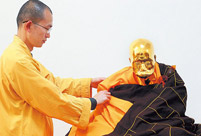

Oolong tea [Photo provided to China Daily]
When you are sipping an aromatic, warming cup of black tea, do you know that for the past 200 years, there have been numerous adventures, conspiracies, rises and falls of empires behind the history of those tea leaves?
What Westerners call black tea is red tea for the Chinese. Although the color of the tea looks black, the leaves and soup after brewing look red.
The Chinese side of the story about the invention of the first black tea, lapsang souchong, started in Tongmuguan, Fujian province's city of Wuyishan. The birth of the tea, the first to reach the Western world from Fujian, originated from an accident.
The story has it that a Chinese army happened to stop by a tea farm in the late Ming Dynasty (1368-1644) and soldiers slept on raw tea leaves intended for green tea making. Helpless and eager to avoid further loss, the anxious tea producer roasted the withered tea leaves immediately afterwards, with pine branches, ending up with a deep colored tea, which produced bright red soup, a smoky taste and sweet flavor.
To the tea farmer's surprise, the unintended taste and flavor became a hit in the market, and the whole area started to make the tea to satisfy market demand.
Around the end of the 16th century and the start of the 17th century, Dutch businesspeople took tea to Europe. Catherine of Braganza, when she married British King Charles II in 1662, took the tea drinking habit from Portugal to the British court.
It was hard to say if residents in the United Kingdom had the choice of drinking green tea, because it is said that after long sea transportation, green tea from China naturally fermented into black tea.
At the time British people still didn't know that black tea and green tea are made from the same leaves, so Scottish botanist Robert Fortune (1812-1880) met with disbelief when he pointed out that only a different processing method made black tea and green tea different.
Fortune was sent by the East India Company to steal tea from China. He took more than 20,000 tea plants and seedlings to the Darjeeling region of India in 1851. Although most of the tea plants he introduced to India are said to have died, trained Chinese tea workers he took there are believed to have equipped the country with the necessary technology and knowledge for tea making.
 |
 French girl ties the knot with Chinese boy
French girl ties the knot with Chinese boy Beijing Style: ready for bare legs
Beijing Style: ready for bare legs Century-old station sees railyway evolution
Century-old station sees railyway evolution Enthusiasts perform Kung Fu at Wudang Mountain
Enthusiasts perform Kung Fu at Wudang Mountain Stunning photos of China's fighter jets in drill
Stunning photos of China's fighter jets in drill Monk's mummified body to be made into a gold Buddha statue
Monk's mummified body to be made into a gold Buddha statue Former Chinese solider of the French Foreign Legion seeks wife online
Former Chinese solider of the French Foreign Legion seeks wife online Asia's longest and highest suspension bridge to open to traffic
Asia's longest and highest suspension bridge to open to traffic China's first interactive robot looks like a beauty
China's first interactive robot looks like a beauty Top 20 hottest women in the world in 2014
Top 20 hottest women in the world in 2014 Top 10 hardest languages to learn
Top 10 hardest languages to learn 10 Chinese female stars with most beautiful faces
10 Chinese female stars with most beautiful faces China’s Top 10 Unique Bridges, Highways and Roads
China’s Top 10 Unique Bridges, Highways and Roads Rousseff’s suspension won’t cure ailing Brazil
Rousseff’s suspension won’t cure ailing Brazil  Reforms, consumption set to boost growth
Reforms, consumption set to boost growth  As police crack down again on sex work, some say legalization is solution
As police crack down again on sex work, some say legalization is solution China recognizes ‘good netizens’ who spread ‘positive energy’
China recognizes ‘good netizens’ who spread ‘positive energy’ Day|Week